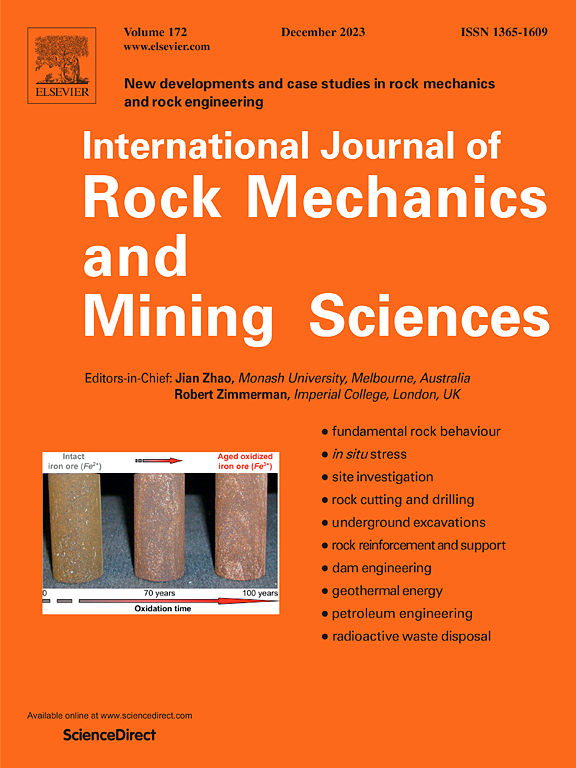微波处理砂岩孔隙结构的多阶段演变:核磁共振的启示
IF 7
1区 工程技术
Q1 ENGINEERING, GEOLOGICAL
International Journal of Rock Mechanics and Mining Sciences
Pub Date : 2024-11-01
DOI:10.1016/j.ijrmms.2024.105952
引用次数: 0
摘要
微波压裂在提高硬岩破碎效率方面具有巨大潜力。然而,被视为岩石在微波辐照下损伤积累和逐渐破坏的孔隙演化仍不清楚。本研究采用核磁共振(NMR)技术研究了不同微波功率水平下砂岩的孔隙演化和断裂机制。结果表明,在不同的微波功率水平下,试样的孔隙演化,包括孔隙大小分布、各种大小孔隙的体积重量和孔隙率,呈现出不同的变化趋势。微波辐照下试样的孔隙演变可分为四个阶段:整体孔隙扩张、内部区域局部孔隙封闭、热应力引起的微裂纹扩展以及宏观裂纹(或熔化)。此外,孔隙演化在结合水的分解和蒸发中也起着至关重要的作用,尤其是当微波处理(TSIMT)引起的热应力导致试样断裂时。采用核磁共振成像(NMRI)描述也为微波辐照下试样的孔隙演变提供了有效的辅助说明。最后,基于核磁共振结果,从微观角度全面讨论了不同功率水平下微波辅助破岩的机理。预计本研究的结果可为提高微波辅助破岩效率提供有价值的见解。本文章由计算机程序翻译,如有差异,请以英文原文为准。
Multi-stage evolution of pore structure of microwave-treated sandstone: Insights from nuclear magnetic resonance
Microwave fracturing has great potential in improving the efficiency of hard rock breaking. However, the pore evolution, which can be regarded as the damage accumulation and progressive failure of the rock subjected to microwave irradiation, remains unclear. In this study, nuclear magnetic resonance (NMR) is employed to investigate the pore evolution and fracture mechanism of the sandstone under different microwave power levels. The results show that the pore evolution of the specimens, including distribution of pore size, the weight in volume of various-sized pore, and porosity, exhibits different changing trends under various microwave power levels. The pore evolution of the specimens under microwave irradiation can be categorized into four phases: overall pore expansion, localized pore closure in the internal region, micro-cracks propagation induced by thermal stress, and macro-cracking (or melting). Moreover, pore evolution also plays a crucial role in the decomposition and evaporation of bound water, particularly when the specimens experience fractures triggered by thermal stress induced by the microwave treatment (TSIMT). The employing of NMR imaging (NMRI) description also provides an auxiliary and effective illustration on the pore evolution of the specimens under microwave irradiation. Finally, the mechanism of microwave-assisted rock breaking under different power levels is comprehensively discussed based on the NMR results from a microscopic perspective. It is anticipated that the findings of this study can provide valuable insights for enhancing the efficiency of microwave-assisted rock breaking.
求助全文
通过发布文献求助,成功后即可免费获取论文全文。
去求助
来源期刊
CiteScore
14.00
自引率
5.60%
发文量
196
审稿时长
18 weeks
期刊介绍:
The International Journal of Rock Mechanics and Mining Sciences focuses on original research, new developments, site measurements, and case studies within the fields of rock mechanics and rock engineering. Serving as an international platform, it showcases high-quality papers addressing rock mechanics and the application of its principles and techniques in mining and civil engineering projects situated on or within rock masses. These projects encompass a wide range, including slopes, open-pit mines, quarries, shafts, tunnels, caverns, underground mines, metro systems, dams, hydro-electric stations, geothermal energy, petroleum engineering, and radioactive waste disposal. The journal welcomes submissions on various topics, with particular interest in theoretical advancements, analytical and numerical methods, rock testing, site investigation, and case studies.

 求助内容:
求助内容: 应助结果提醒方式:
应助结果提醒方式:


